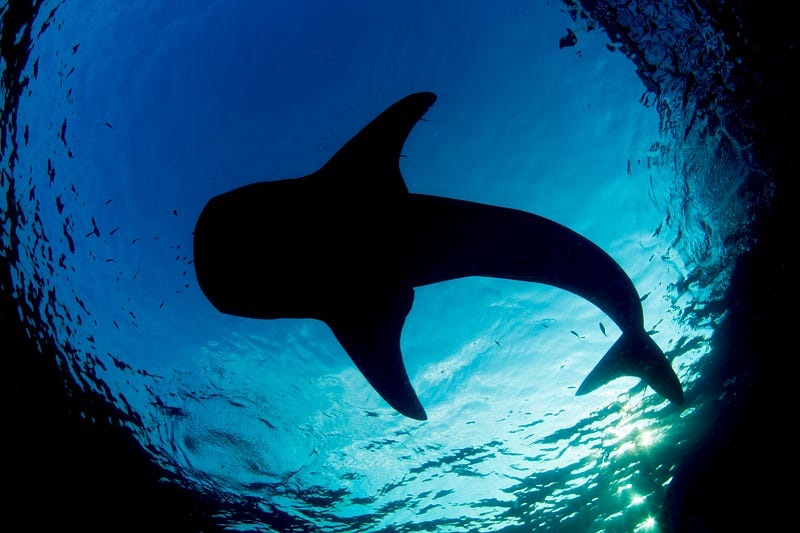# Is Bigger Always Better? Exploring Size in Evolutionary Biology
Written on
Chapter 1: The Fascination of Size in Nature
During my scuba diving adventures in Oslob Bay, located off the coast of Cebu Island in the Philippines, I spotted a small shadow flitting over a coral block. It was a diminutive goby from the genus Eviota, one of the smallest vertebrates known, measuring only about one centimeter and weighing less than a tenth of a gram. This tiny creature, roughly a million times smaller than myself, shares fundamental vertebrate features such as a spinal cord, a bony skull, a brain, kidneys, and a liver. Although its organs are the same in type, they exist on a vastly different scale.
But my interest in Oslob was not solely to observe gobies. As I swam away from the coral and approached the shore, I noticed the sunlight dimming—not due to cloud cover, but because an enormous creature was gliding above me. I was thrilled to see a whale shark, Rhincodon typus, the largest fish on the planet. Mature individuals can weigh up to 34 tons, which is more than 300 times my weight. The size difference between the tiny goby and the whale shark represents a staggering eight orders of magnitude, showcasing the incredible diversity of animal sizes on Earth.

The whale shark, the largest living fish. Photo: Brett Lobwein/Barcroft Images/Barcroft Media via Getty Images
Chapter 2: The Advantages of Being Large
The striking contrasts in animal size have intrigued biologists for over a century. Larger animals enjoy several benefits, including a reduced risk of predation. For instance, some small gobies face a predation rate exceeding 6 percent daily, whereas whale sharks can live for decades and are known to survive attacks from tiger sharks. Additionally, larger animals tend to invest more in reproduction; a female goby produces around 250 eggs in her lifetime, while a female whale shark can give birth to several hundred fully developed pups, each measuring over half a meter long.
Larger body sizes also confer other advantages. For instance, warm-blooded animals find it easier to maintain a stable body temperature due to a more favorable surface-to-volume ratio. In herbivores, the increased intestinal volume facilitates more efficient fermentation, which is crucial for digesting plant matter. Clearly, there are significant advantages to being large.

Manta birostris, the manta ray, the world’s largest ray, which can reach wingspans of up to seven meters. Photo: Prisma Bildagentur/UIG via Getty Images
Chapter 3: Cope's Rule and Evolutionary Trends
Many animal lineages have significantly increased in size throughout their evolutionary history. This phenomenon is referred to as Cope’s Rule, named after 19th-century American paleontologist Edward Drinker Cope. Notable examples include dinosaurs, which evolved from a relatively large reptile that existed during the mid-Triassic period, and eventually grew into some of the largest terrestrial creatures ever, such as Titanosaurs, measuring up to 37 meters long.
Cetaceans, including whales and dolphins, also illustrate this trend. These marine mammals evolved from a cat-sized amphibious ancestor, Indohyus, around 48 million years ago. As they adapted to an aquatic lifestyle, their size increased dramatically, with ancient Basilosaurid whales reaching lengths of 25 meters. The trend has continued, culminating in the blue whale, which is the largest animal ever known, capable of growing up to 30 meters and weighing nearly 200 tons.
Despite the benefits of larger body sizes, one may wonder why not all species are large. One reason is that smaller species can diversify into new species more rapidly. A recent theoretical study conducted with Timothy Quimpo at the University of the Philippines established a link between the abundance of smaller animals and the speed of speciation. Thus, while some species may evolve toward larger sizes following Cope's Rule, numerous smaller species proliferate, resulting in a predominance of small animals.
What If The Earth Was 10 Times Bigger? - This video explores the implications of significantly increasing the size of our planet, examining how it would impact life as we know it.
What if the Earth Became Bigger Than the Sun? - A thought-provoking video that discusses the consequences of Earth's size exceeding that of the Sun, and how it would affect the solar system.
Chapter 4: Ecological Factors and Size Limitations
It is important to recognize that biological "rules" are generally less rigid than the laws of physics. Exceptions to Cope's Rule do exist, as the advantages of larger sizes can depend on ecological and anatomical factors. For example, early birds did not grow larger; flying becomes increasingly challenging with increased size. In North America, freshwater fish have even decreased in size over time, likely due to their adaptation to smaller bodies of water.
Ecological conditions, such as mass extinctions, also favor smaller sizes. The mass extinction event at the end of the Cretaceous is believed to have been caused by a meteorite impact 66 million years ago, which led to widespread ecological disruption. This event eliminated terrestrial dinosaurs, and only a few small animals survived, with nothing larger than 25 kilograms remaining.
Another significant extinction occurred at the end of the Permian epoch, approximately 250 million years ago, resulting in the loss of an estimated 95 percent of marine species due to massive volcanic activity that drastically altered the atmosphere. The early Triassic period, which followed this extinction, was marked by a notable lack of biodiversity, as the larger land reptiles vanished, leaving only smaller species like the dog-sized Lystrosaurs.
Regrettably, the study of mass extinctions is not merely an academic concern; we are currently experiencing a human-induced mass extinction. Since our species migrated from Africa, we have driven numerous species to extinction, first as hunters and then through significant environmental alterations following the advent of agriculture. Since the Industrial Revolution, our activities have drastically changed the planet's atmospheric composition, leading to global climate change and further altering ecological conditions for countless species.
Biologists continue to debate whether these changes are as severe as those during the previous five major extinction events, but they are undoubtedly significant.
The term "Anthropocene," or the "human age," has been proposed to describe our current geological epoch, where megafauna (animals weighing more than 25 kilograms) have suffered greatly wherever humans have settled. Our ancestors likely played vital roles in the extinction of large animals like North America's giant ground sloths and Australia's horse-sized wombats. Today, ongoing hunting and environmental modifications disproportionately threaten larger species. An alarming example is the Steller's sea cow, a massive relative of the dugong that was discovered in 1741 and hunted to extinction within just 27 years.
Klaus M. Stiefel is an author and neuroscientist affiliated with the NeuroLinx Research Institute. He wrote The Camera and The Brain: What Visual Neuroscience Can Teach the Photographer (2016) and currently resides in the Philippines.